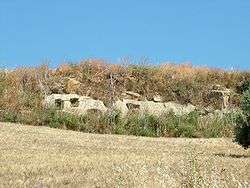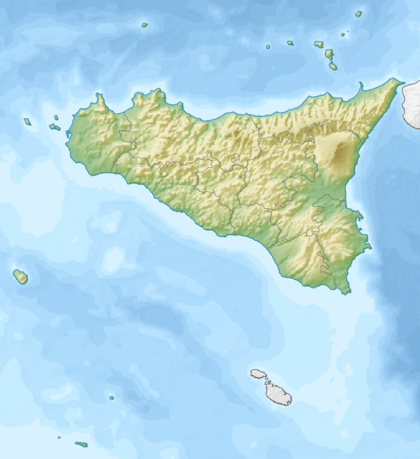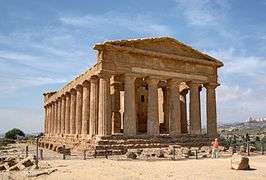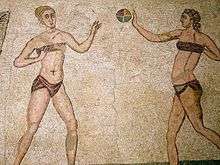Sabucina
 The grotticella tombs of Sabucina | |
 Shown within Sicily | |
| Location | Caltanissetta, Sicily, Italy |
|---|---|
| Coordinates | 37°30′9.47″N 14°7′15.82″E / 37.5026306°N 14.1210611°E |
| History | |
| Periods | c.2300-300 BC |
| Site notes | |
| Archaeologists | Piero Orlandini |
The archaeological park of Sabucina (officially, Sabbucina), located on the mountain of the same name near Caltanissetta (8 km to the north east), is an archaeological site in Sicily. The area contains settlements ranging from the Bronze Age (20th-16th century BC) to the Roman period.[1]
History
Archaeological evidence allows the phases of habitation to be divided as follows:
- 23rd-15th century BC: some villages of the Castelluccio culture
- 13th-10th century BC: village of huts of the northern Pantalica culture (threephases)
- 10th-9th century BC: slight habitation by the Cassibile culture
- 8th-7th century BC: new settlement with rectangular houses and an organised religious area
- 6th-4th century BC: settlement of Greek colonists from Gela.
The original village has securely pre-Greek origins, it was constructed by the Sicans, who took advantage of the dominant position of the mountain over the Salso river valley.
Greek period
The first phase of the Greek settlement came in the 7th century. The centre consisted of rectangular habitations, with more space between them towards the summit of the mountain. In the 6th century BC, the city wall was built, which probably contained the entire inhabited area at that time. In the 5th century the settlement was destroyed, probably by Ducetius, who is mentioned by Diodorus Siculus. Reconstruction occurred in the second half of the century; the settlement received a new layout of streets and housing plots on a different orientation, and a new city wall with rectangular towers. This settlement was abandoned in turn at the end of the fourth century, probably as a result of the Agathocles of Syracuse.[2]
Archaeological area
In the area at the bottom of the mountain are some Bronze Age grotticella tombs; other important discoveries include to a hut used as a shrine and the so-called Sacello of Sabucina, a terracotta model dating to the 6th century BC, found in the area of the necropolis, which depicts a small temple with a pronaos in antis and a pitched roof surmounted by two figures of cavalrymen and two gorgoneion masks decorating the tympanum. The sacello, with other discoveries, is now kept in the Regional archaeological museum of Caltanissetta.
The discovery of this archaeological site is relatively recent; the first excavations only took place in the 1960s, when Piero Orlandini excavated the late Bronze Age huts, dating to the 13th-10th centuries BC. This was an important excavation, since Sabucina was the first village of this type to be identified in Sicily.
Today the site is accessible, thanks to a regulation of the Office of Cultural Heritage. As a result of public order n.6262 on 11 July 2001 it became the regional archaeological park of Sabucina.[3]
References
| Wikimedia Commons has media related to Sabucina. |
- ↑ "Sabucina - Siciliantica". Retrieved 13 September 2012.
- ↑ La Rosa 1989, p. 62.
- ↑ Lorenzo Quilici; Stefania Quilici Gigli (2002). La via Appia: iniziative e interventi per la conoscenza e la valorizzazione da Roma a Capua. L'ERMA di BRETSCHNEIDER. pp. 56–. ISBN 978-88-8265-228-9.
Bibliography
- La Rosa, Vincenzo (1989). "Le popolazioni della Sicilia: Sicani, Siculi, Elimi". Italia omnium terrarum parens. Milano: Libri Scheiwiller. Collana Antica Madre, XII. pp. 3–110.
- Rosalba Panvini (2009). La Sicilia in età arcaica: dalle apoikiai al 480 a.C. Centro regionale per l'inventario, la catalogazione e la documentazione. ISBN 978-88-903321-8-0.
- Filippo Giudice; Rosalba Panvini (2003). Il greco, il barbaro e la ceramica attica: immaginario del diverso, processi di scambio e autorappresentazione degli indigeni. L'erma di Bretschneider. p. 79. ISBN 978-88-8265-320-0.
- Francesco Carubia (2012). Sicani: il Minotauro, l'agenda rossa di Borsellino ed i sacri misteri. Youcanprint. pp. 73–. ISBN 978-88-6751-141-9.
- Tamar Hodos (2006). Local Responses to Colonization in the Iron Age Mediterranean. Routledge. p. 126. ISBN 978-1-134-18281-7.
- Robert Leighton (1999). Sicily Before History: An Archaeological Survey from the Palaeolithic to the Iron Age. Cornell University Press. pp. 284–. ISBN 0-8014-8585-1.
- Istituto per gli studi micenei ed egeo-anatolici (Italy) (1991). dal palazzo alla città : atti del Convegno Internazionale Roma, 14-19 Marzo 1988. Istituto per gli Studi Micenei ed Egeo-Anatolic.
- Marisa Sedita Migliore (1981). Sabucina: studio sulla zona archeologica di Caltanissetta. S. Sciascia.
- Caterina Barilaro (2004). I parchi letterari in Sicilia: un progetto culturale per la valorizzazione del territorio. Rubbettino Editore. pp. 165–. ISBN 978-88-498-0863-6.
- Guglielmo Capozzo (1840). Memorie su la Sicilia tratte dalle più celebri accademie e da distinti libri di società letterarie e di valent' uomini nazionali e stranieri, con aggiunte e note. pp. 200–.
External links
- "Area archeologica di Sabucina". Retrieved 17 March 2015.
- Gaspare Mannoia. "Sabucina". youtube.

